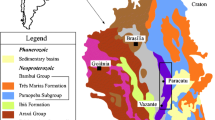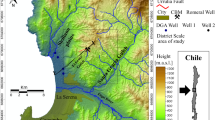Abstract
Karstic landforms abound in the vicinity of the Uchucchacua mine (4,500–5,000 m a.s.l.). These help infiltration and the rapid inflow of water, which penetrates even the deepest working levels of the mine. These inflows affect mining operations and the mine has to be drained. In wet months, high volumes of mine water must be pumped, and these volumes are drastically reduced in dry months. Mine water is collected and drains by gravity along the Patón Tunnel. The mine dewatering has created drawdown cones, so modifying natural groundwater flow patterns. Surface water and groundwater are interconnected because of the karst, and this influences the volume of mine water that must be pumped from the mine. Direct infiltration occurs via dolines and sinkholes, and along the main interconnected open faults and mineral veins, leading to very high infiltration rates overall. The current study aims to evaluate the impact of meteoric water on mining operations.
Access provided by Autonomous University of Puebla. Download chapter PDF
Similar content being viewed by others
Keywords
1 Introduction
The Uchucchacua mine is situated in the Central Highlands of Peru, in Oyón province (Lima district) at an elevation of between 4,500 and 5,000 m a.s.l., close to the watershed of the Huaura basin. Precipitation mainly occurs between December and March, with an annual mean of 1160 mm. The mean annual temperature is 4 °C.
Underground mining operations have continued since colonial times in the three sectors of Carmen, Socorro and Huantajalla. The mineral deposits are epigenetic, arising from the infill of fractures (veins), flow channels and from metasomatic replacement from hydrothermal solution. Numerous old mine workings of this silver deposit still exist in the Nazareno, Mercedes, Huantajalla and Casualidad areas of the Central Highlands. In the early 1960s, the Buenaventura Mines Company began prospecting and, in 1975, they installed an industrial plant. Today, this has a treatment capacity in excess of 4,000 tonnes/day.
The current study aims to assess how surface water affects the underground mine workings, and determine the extent of meteoric water flow into the mine (Apaza 2013), since this inflow creates the need for intensive pumping in the mine during wet periods. However, the need for pumping is drastically reduced during dry months (Fig. 1).
2 Materials and Methods
The geology of the area indicates an extensive outcrop of Upper Cretaceous calcareous rocks, known as the Jumasha Formation, which is 1,460 m thick. This underlies the marl of the Calendín Formation and overlies the sandstone of the Goyllarisquizga Formation, which outcrops in the southwestern part of the study area.
Limestone is the main aquifer in the area, which is formed by three large units. The first is the Lower Jumasha formation, up to 570 m thick, composed of alternating marly limestone and nodular limestone with chert. The second unit—the Middle Jumasha formation—has an estimated thickness of 485 m and comprises pale grey limestone alternating with nodular limestone with some marly horizons. The Upper Jumasha formation, with an estimated thickness of 405 m, exhibits a more diverse lithology of fine-grained limestone, with carbonaceous schist at the base and beige marly limestone at the top (Jacay 2005). The area suffered intense glacial activity in the Pleistocene period, creating U-shaped valleys above 3,800 m. a.s.l., which were subsequently infilled by lateral and frontal moraines as the glaciers receded. Towards the north, there are extensive moraine trails (INGEMMET 1996) (Figs. 2 and 3).
Tectonic activity favoured the intrusion of dacite, riolite and mineral-rich hydrothermal solutions that formed the veins of the mineral deposit exploited for its silver sulphosalt minerals (proustite and pyrargyrite). Zinc (blende) is extracted as a subproduct, and there is also a wide range of other minerals.
The hydrogeology of the area is dominated by karstic limestone; there is a small proportion of fractured limestone, which are frequent in the high-altitude zones. The most important aquifer corresponds to the limestone of the Jumasha Formation; of these, the Middle Jumasha limestone are the most soluble and show greater karstification (Evans et al. 2005). Here, there is greater percolation of rainwater, with rapid flow towards the saturated zone. From the saturated zone, water flows laterally and intercepts the deepest levels of the underground mine.
The hydrogeological mapping allowed identification of the hydrogeological units based on their lithology. An inventory of springs and bofedales (spring-fed wetlands in the altiplano), infiltrations into the mining galleries, as well as flow in boreholes, discharges from anomalous structures during the drilling of hydrogeological boreholes and excavation of soil pits have been done. In addition, two hydrochemical sampling surveys were done (wet season and dry season) over a network of river and lagoon sites. Three groundwater surveys were completed, including flow gauging of springs and mine water; piezometric level measurements have also been done.
The investigation involved drilling of thirteen boreholes in February 2014, with different deeps, between 40.2 and 150 m. These were subject to hydraulic tests, including Lefranc, Lugeon and slug-tests at 8 m intervals. A log of the borehole lithology was also made, describing discontinuities and karstified reaches, and measurement of water levels.
3 Results and Discussion
The data of hydraulic tests were grouped into three units: moraine sediments, massive limestone and slightly karstified fractured limestone. Values were classified according to rock type and size of grain (in the case of unconsolidated sediments). The data are shown in Table 1.
Recharge occurs by infiltration of rainwater and snowmelt. The greatest recharge is produced over areas of bare limestone rock and through the deposits of granular sediments that retain runoff water. The dolines with sinkholes are the greatest recharge points. The mean recharge rate is estimated to be between 40 and 70 % of the total precipitation. This is a moderate–high rate, highly conditioned by the anisotropy of limestone.
The hydrogeological catchment exceeds the hydrological one and receives recharge from outside its watershed. The piezometry indicates a concentration of flows towards the south-west, which coincides with the pattern of surface drainage. In dry months, there is no significant groundwater discharge. In wet months, by contrast, springs rise in the low points of the basin, reaching peak flows of 693 l/s, located in fractures areas, zones of lithological contact and fluvioglacial sediments. It is calculated that the largest discharges occur towards Añilcocha Lake, which is the lowest hydrological point (Fig. 4).
Mining operations have modified the natural flow regime creating drawdown cones, which cause mine drainage to converge towards the Patón tunnel, which serves as the drain for the mine. Underground mining in the Uchucchacua mine occurs in three zones: Socorro, Carmen and Huantajalla, situated 470 m below the ground surface. Ore extraction occurs between 4,550 and 4,120 m. a.s.l., with an even deeper level between 4,120 and 3,990 m a.s.l. The mine is dewatered using a system of submersible pumps. The water from higher and lower levels is collected at the 3,990 m level and diverted into a drainage tunnel that takes it to the Patón lagoon (Fig. 5).
At the time of writing, seasonal pumped flows of mine water oscillate between 141 l/s in the dry months and 1,504 l/s in wet months (Fig. 6). The discharges vary through the mine, with the greatest flows coming from levels 3,990 and 4,180 m. There was a marked increase in inflow between April 2013 and February 2014. Mine drainage occurs via two main drainage systems (Patón and Huantajalla tunnels extending to the ground surface), which discharge between 2,022 l/s in wet months and 146 l/s in dry months.
Interconnection between surface water and groundwater clearly encourages inflow into the deeper levels of the mine, especially at the 3,780 m a.s.l. mine level. As indicated above, infiltration occurs through dolines, sinkholes and the interconnected open faults and main mineral veins. These favour a high rate of infiltration—in the range of 40–70 %—due to the large percolation capacity that derives from the pronounced karstification of the aquifer (Fig. 7).
The dominant water type of the groundwater in this area is calcium sulphate. TDS of these waters varies from the minima observed in the springs (208–434 mg/l) to the peak TDS observed inside the mine (521–1,680 mg/l). There is also calcium bicarbonate waters, which exhibit the lower TDS values (124–198 mg/l). Water inside the mine interacts with water in the mineralised zone, which is slightly acid. As a consequence of mixing with percolation water, it becomes alkaline, with a low metalloid content.
The interconnection that exists between surface water and groundwater clearly influences the volume of water reaching the deepest part of the mine, especially at the 3,780 m.a.s.l. level. This influence is demonstrated by the chloride content. Groundwater springs and resurgences have very low chloride content (0.6–2.0 mg/l), while water samples from inside the mine has higher values (1.2–13.0 mg/l). Nevertheless, in February 2014 (corresponding to a wet period), chloride values fell drastically as a result of mixing with inflows derived from rainwater. At this time, groundwater samples from the upper levels of the aquifer fluctuated between 0.1 and 1.0 mg/l, while concentrations in water collected inside the mine were between1.1 and 10.3 mg/l.
4 Final Considerations
The Uchucchacua mine is situated in the karstic limestone of the Jumasha Formation, whose numerous karstic landforms allow rapid percolation and flow into the deeper working levels of the mine. These flows affect mining activities. The dewatering operations have modified the natural flow regime, creating drawdown cones and diverting mine water into the Patón tunnel, which acts as a drain for the mine.
Presently, mean monthly flows of pumped mine water are between 141 l/s (dry months) and 1,504 l/s (wet months). The discharge is not homogeneous through the mine, with the greatest flows coming from the mine levels at 3,780 and 4,180 m a.s.l. There was a marked increase in flow between April 2013 and February 2014. The more saline mine waters have a calcium sulphate type, with TDS of 521–1,680 mg/l, while less saline waters have a calcium bicarbonate type and TDS of 124–198 mg/l.
This study highlights the interconnection that exists between surface waters and groundwater in the study area and shows how surface flows influence the volume of water that has to be drained from the deeper levels of the mine, especially from the 3,780 m level. Direct infiltration occurs through dolines, sinkholes, interconnected open faults and mineral veins, with a high rates of recharge.
The conceptual model proposed will be refined on the basis of new hydrochemical data, data from newly-installed piezometers, including water level measurements and monitoring of groundwater and mine water discharges. The results of these studies will be used to propose management actions aimed at reducing the rate of percolation into the karst.
References
Apaza D (2013) Evaluación Hidrogeológica de Las Labores Subterráneas—Mina Uchucchacua, Fase I. Informe inédito Compañía Minas Buenaventura S.A.A. Hidroandes Consultores S.A.C, San Isidro
INGEMMET (1996) Boletín Geología del Cuadrángulo Oyón, Hoja 22-J
Jacay J (2005) Análisis de la sedimentación del sistema cretáceo de los Andes del Perú Central. Revista del Instituto de Investigación FIGMMG 8(15):49–59
Evans D, Letient H, Aley T (2005) Aquifer vulnerability mapping in karstic terrain Antamina mine. Perú Infominer 3(6):1–13
Acknowledgments
We grateful for the helpful corrections and suggestions made by anonymous reviewers, which improved the article. Similarly to the Compañía de Minas Buenaventura S.A.A, for permission to use the information from mine.
Author information
Authors and Affiliations
Corresponding author
Editor information
Editors and Affiliations
Rights and permissions
Copyright information
© 2015 Springer-Verlag Berlin Heidelberg
About this chapter
Cite this chapter
Apaza-Idme, D., Pulido-Bosch, A., Sánchez-Martos, F. (2015). Karstic Hydrogeology of the Uchucchacua Underground Mine (Perú) and Its Interaction with Surface Waters. In: Andreo, B., Carrasco, F., Durán, J., Jiménez, P., LaMoreaux, J. (eds) Hydrogeological and Environmental Investigations in Karst Systems. Environmental Earth Sciences, vol 1. Springer, Berlin, Heidelberg. https://doi.org/10.1007/978-3-642-17435-3_54
Download citation
DOI: https://doi.org/10.1007/978-3-642-17435-3_54
Published:
Publisher Name: Springer, Berlin, Heidelberg
Print ISBN: 978-3-642-17434-6
Online ISBN: 978-3-642-17435-3
eBook Packages: Earth and Environmental ScienceEarth and Environmental Science (R0)











